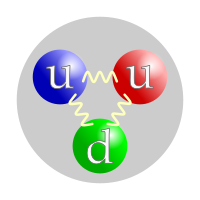
Photo from wikipedia
We performed a theoretical analysis on the relevance of the small frequency separation $\delta \nu$ in determining stellar ages, masses, and radii. We adopted the SCEPtER pipeline for low-mass stars,… Click to show full abstract
We performed a theoretical analysis on the relevance of the small frequency separation $\delta \nu$ in determining stellar ages, masses, and radii. We adopted the SCEPtER pipeline for low-mass stars, [0.7, 1.05] Msun. Synthetic stars were generated and reconstructed assuming different relative precision in $\delta \nu$ (5% and 2%). The quantification of the systematic errors arising from a mismatch between synthetic stars and the recovery grid was also performed. The biases were negligible. The statistical error in age estimates was strongly dependent on the stellar evolutionary phase. It is at its maximum at ZAMS and decreases to about 11% and 6% ($\delta \nu$ at 5% and 2% level) when stars reach the 30% of their evolutionary MS lifetime, then vanishes in the last 20% of the MS. For mass and radius estimates we detected nearly identical behavior for an observational uncertainty of 5%. No benefit was detected for mass and radius determinations from a reduction $\delta \nu$ precision to 2%. The impact on the age of the initial helium abundance resulted in negligible results. On the other hand greater bias (2% and 1%) in mass and radius estimates were detected whenever $\delta \nu$ is in the observational pool. This result, together with the presence of further unexplored uncertainty sources, suggest that precision in the derived stellar quantities below these thresholds may possibly be overoptimistic. [...] Finally, we compared the estimates by the SCEPtER pipeline for 13 Kepler asteroseismic LEGACY sample stars with those given by six different pipelines. Overall, on the LEGACY sample data, we obtained a multi-pipeline precision of about 4.4%, 1.7%, and 11% on the estimated masses, radii, and ages, respectively.
Journal Title: Astronomy and Astrophysics
Year Published: 2020
Link to full text (if available)
Share on Social Media: Sign Up to like & get
recommendations!